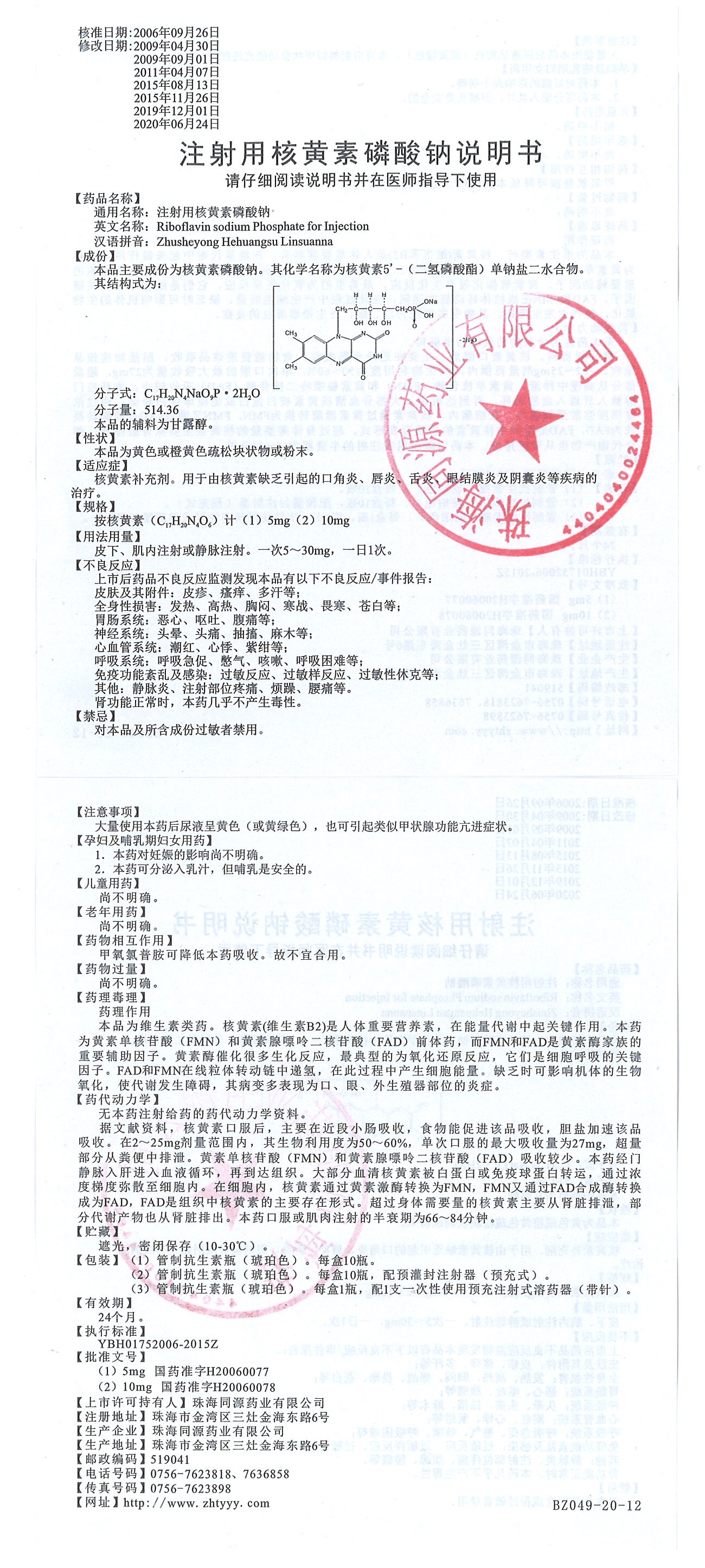



核黄素补充剂。用于由核黄素缺乏引起的口角炎、唇炎、舌炎、眼结膜炎及阴囊炎等疾病的治疗。
Packaging: 1000瓶/件
Specification: 10mg
Shelf Life: 24个月
Approval Number: 国药准字H20060078
Indications: 核黄素补充剂。用于由核黄素缺乏引起的口角炎、唇炎、舌炎、眼结膜炎及阴囊炎等疾病的治疗。
Detail
1.高效抗氧化,加快细胞修复,提高粘膜稳定性;
2.新型维生素衍生物产品,全科用药,市场容量大;
3.专利品种;
4.质量标准起草单位,内控标准高于国家标准;
5.琥珀色西林瓶,更符合法定储存要求,安全稳定;
6.除普包外,另增加预充式包装;

核黄素是黄素酶辅基的主要组成部分,参与机体复杂的生物氧化过程,具有重要的药理作用。核黄素是水溶性维生素,易从汗液及尿中排除体外,半衰期短,生物利用度低,极易引起各种核黄素缺乏症。我国流行病学的调查表明。核黄素缺乏病的发病率为20%-40%。人体对于核黄素的吸收代谢具有很高要求,不同的核黄素制剂可以产生不同的生物利用度。核黄素磷酸钠是新型核黄素制剂,其溶解性好,易吸收,无刺激性,稳定性好,安全性高。
【药品名称】
通用名称:注射用核黄素磷酸钠。
英文名称:Riboflavin sodium Phosphate for Injection
汉语拼音:Zhusheyong Hehuangsu Linsuanna
【成份】
本品主要成份为核黄素磷酸钠。其化学名称为核黄素5′–(二氢磷酸酯)单钠盐二水合物。
其结构式为:


分子式:C17H20N4NaO9P·2H2O
分子量:514.36
本品的辅料为甘露醇。
【性状】
本品为黄色或橙黄色疏松块状物或粉末。
【适应症】
核黄素补充剂。用于由核黄素缺乏引起的口角炎、唇炎、舌炎、眼结膜炎及阴囊炎等疾病的治疗。
【规格】按核黄素(C17H20N4O6)计(1)5mg(2)10mg
【用法用量】
皮下、肌内注射或静脉注射。一次5~30mg,一日1次。
【不良反应】
1.肾功能正常时,本药几乎不产生毒性。
2.偶有过敏反应。
【禁忌】
对本药过敏者禁用。
【注意事项】
大量使用本药后尿液呈黄色(或黄绿色),也可引起类似甲状腺功能亢进症状。
【孕妇及哺乳期妇女用药】
1.本药对妊娠的影响尚不明确。
2.本药可分泌入乳汁,但哺乳是安全的。
【儿童用药】
尚不明确。
【老年用药】
尚不明确。
【药物相互作用】
甲氧氯普胺可降低本药吸收。故不宜合用。
【药物过量】
尚不明确。
【药理毒理】
药理作用
本品为维生素类药。核黄素(维生素B2)是人体重要营养素,在能量代谢中起关键作用。本药为黄素单核苷酸(FMN)和黄素腺嘌呤二核苷酸(FAD)前体药,而FMN和FAD是黄素酶家族的重要辅助因子。黄素酶催化很多生化反应,最典型的为氧化还原反应,它们是细胞呼吸的关键因子。FAD和FMN在线粒体转动链中递氢,在此过程中产生细胞能量。缺乏时可影响机体的生物氧化,使代谢发生障碍,其病变多表现为口、眼、外生殖器部位的炎症。
【药代动力学】
无本药注射给药的药代动力学资料。
据文献资料,核黄素口服后,主要在近段小肠吸收,食物能促进该品吸收,胆盐加速该品吸收。在2~25mg剂量范围内,其生物利用度为50~60%,单次口服的最大吸收量为27mg,超量部分从粪便中排泄。黄素单核苷酸(FMN)和黄素腺嘌呤二核苷酸(FAD)吸收较少。本药经门静脉入肝进入血液循环,再到达组织。大部分血清核黄素被白蛋白或免疫球蛋白转运,通过浓度梯度弥散至细胞内。在细胞内,核黄素通过黄素激酶转换为FMN,FMN又通过FAD合成酶转换成为FAD,FAD是组织中核黄素的主要存在形式。超过身体需要量的核黄素主要从肾脏排泄,部分代谢产物也从肾脏排出。本药口服或肌肉注射的半衰期为66~84分钟。
【贮藏】避光,密闭保存(10-30℃)。
【包装】(1)管制抗生素瓶(琥珀色)。每盒10瓶。
(2)管制抗生素瓶(琥珀色)。每盒10瓶,配预灌封注射器(预充式)。
(3)管制抗生素瓶(琥珀色)。每盒1瓶,配1支一次性使用预充注射式溶药器(带针)。
【有效期】24个月。
【执行标准】YBH01752006-2015Z
【批准文号】
(1) 5mg 国药准字H20060077
(2) 10mg 国药准字H20060078